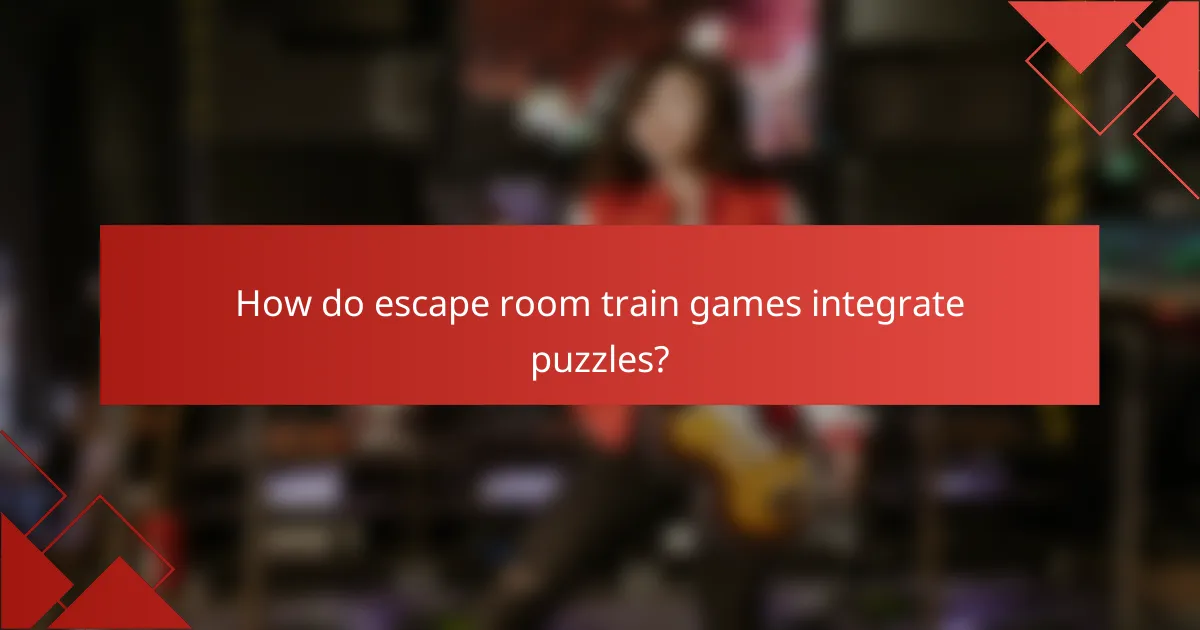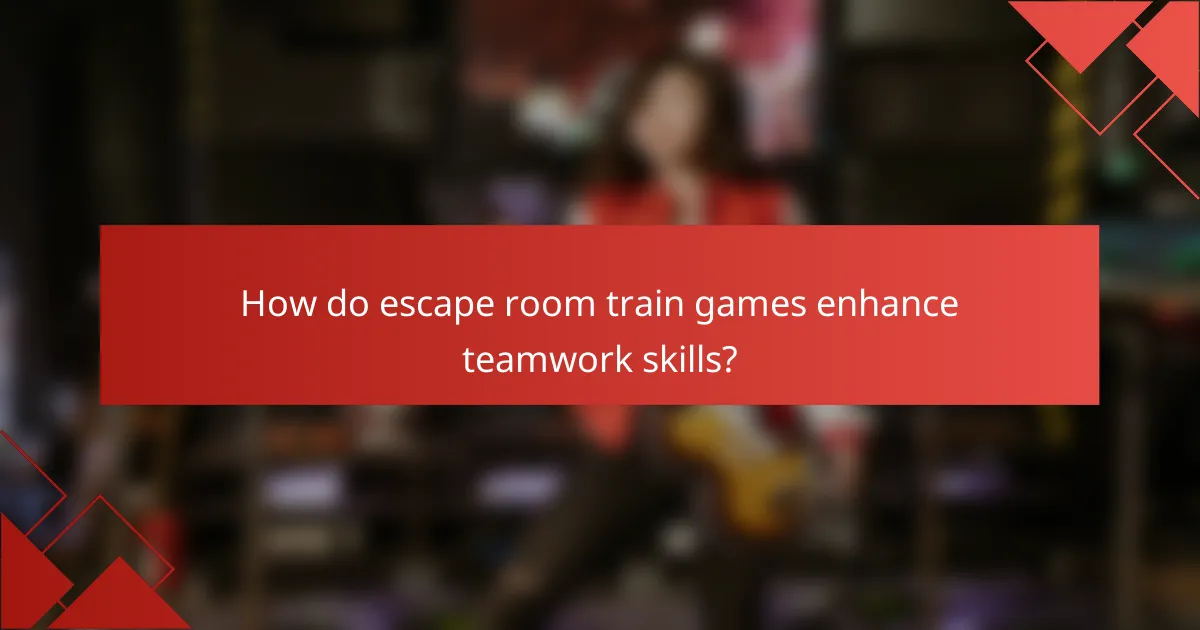Escape room train games offer a unique blend of immersive storytelling and challenging puzzles that require teamwork and critical thinking. With time limits typically set between 60 to 90 minutes, players must collaborate effectively under pressure to solve intricate challenges. The dynamics within each group play a crucial role in determining their success, as communication and cooperation are essential for navigating the game’s complexities.

How do escape room train games integrate puzzles?
Escape room train games integrate puzzles by embedding various challenges within the gameplay that require teamwork and critical thinking to solve. These puzzles are designed to enhance the immersive experience, often with a narrative that ties them together, making the game engaging and interactive.
Puzzle types in escape room train games
In escape room train games, puzzles can be categorized into several types, including logic puzzles, physical challenges, and riddles. Logic puzzles often involve pattern recognition or deduction, while physical challenges may require players to manipulate objects or navigate through spaces. Riddles typically test players’ lateral thinking and creativity.
Additionally, puzzles may be designed for individual or group solving, encouraging collaboration among players. This dynamic enhances the social aspect of the game, as participants must communicate effectively to progress.
Examples of popular puzzle mechanics
Common puzzle mechanics in escape room train games include combination locks, hidden objects, and code-breaking tasks. Combination locks require players to find clues that lead to the correct sequence, while hidden objects may be concealed within the train’s environment, prompting exploration.
Code-breaking tasks often involve deciphering messages or symbols, which can be a thrilling challenge for teams. These mechanics not only test players’ problem-solving skills but also contribute to the overall narrative, making each puzzle feel integral to the game’s storyline.

What are the time limits in escape room train games?
Time limits in escape room train games typically range from 60 to 90 minutes, depending on the complexity of the puzzles and the design of the game. These constraints create a sense of urgency, pushing teams to collaborate effectively to solve challenges within the allotted time.
Standard time limits for escape room games
Most escape room train games adhere to a standard time limit of 60 minutes. However, some may offer extended sessions of up to 90 minutes for more intricate scenarios. It’s essential to check the specific game details, as variations exist based on the theme and difficulty level.
In addition to the standard time limits, some venues may provide options for shorter games, lasting around 30 to 45 minutes, which can be ideal for beginners or those looking for a quick experience.
Impact of time limits on gameplay
Time limits significantly influence gameplay dynamics, fostering teamwork and communication among participants. The pressure of a ticking clock encourages players to strategize and prioritize tasks, often leading to more engaging and immersive experiences.
However, strict time constraints can also lead to stress and frustration if teams feel overwhelmed. To mitigate this, players should focus on clear roles and responsibilities, ensuring everyone contributes to solving puzzles efficiently.

How do group dynamics affect escape room train games?
Group dynamics significantly influence the success of escape room train games by shaping communication, collaboration, and problem-solving among participants. The interactions within a team can either enhance or hinder their ability to solve puzzles and complete challenges within the time limit.
Roles within a team during gameplay
Each member of a team typically adopts specific roles that can enhance overall performance. Common roles include the leader, who coordinates efforts; the communicator, who shares information; and the puzzle solver, who focuses on deciphering clues. Recognizing and leveraging these roles can streamline the gameplay experience.
For example, a leader can help maintain focus and keep the team on track, while a communicator ensures that all members are aware of progress and findings. This division of labor allows for a more efficient approach to tackling the various challenges presented in the game.
Strategies for effective team collaboration
Effective collaboration in escape room train games can be achieved through clear communication and strategic planning. Teams should establish a method for sharing information quickly, such as designating a central location for clues or using a whiteboard to track progress. This helps prevent confusion and keeps everyone informed.
Additionally, setting time limits for discussing each puzzle can encourage prompt decision-making and prevent stagnation. Teams should also practice active listening, ensuring that all ideas are considered, which fosters a more inclusive environment and enhances problem-solving capabilities.

What are the best escape room train games available?
The best escape room train games combine immersive storytelling, challenging puzzles, and engaging group dynamics. These games typically involve players working together within a set time limit to solve clues and escape from a themed train environment.
Top-rated escape room train games in the US
In the United States, some of the top-rated escape room train games include “Escape the Train” and “The Great Train Heist.” These games often feature intricate storylines and a variety of puzzles that require teamwork and communication.
Players can expect to face time limits ranging from 60 to 90 minutes, with difficulty levels varying from beginner to expert. It’s advisable to book in advance, especially during weekends or holidays, as these popular games can fill up quickly.
Popular escape room train games in Europe
Europe offers a range of popular escape room train games, such as “The Mystery of the Orient Express” and “Train to Nowhere.” These games often incorporate local history and culture, enhancing the overall experience for participants.
Similar to their US counterparts, these games typically have time limits of around 60 minutes. Players should consider the group size, as some games are designed for larger teams, which can affect the dynamics and enjoyment of the experience.

What criteria should you consider when choosing an escape room train game?
When selecting an escape room train game, consider factors like the complexity of puzzles, time limits, and group dynamics. These elements significantly influence the overall experience and enjoyment for participants.
Factors influencing game selection
Several factors can affect your choice of an escape room train game. First, consider the theme and storyline, as these can enhance engagement. Additionally, the physical space and layout of the train can impact how puzzles are integrated and how players interact with their environment.
Another important factor is the duration of the game. Most escape room train games range from 60 to 90 minutes, which can affect how many puzzles can be included and the overall pacing of the experience. Make sure to choose a game that fits within your group’s schedule and attention span.
Player experience levels and game difficulty
Understanding the experience levels of your group is crucial when selecting a game. If players are new to escape rooms, opt for games with moderate difficulty and clear instructions. Conversely, experienced players may seek more challenging puzzles that require advanced problem-solving skills.
Game difficulty often correlates with the complexity of the puzzles and the time limits imposed. A game designed for beginners might have simpler clues and a longer time limit, while advanced games could feature intricate puzzles and tighter time constraints. Assess your group’s preferences and skills to ensure a balanced challenge that promotes teamwork and enjoyment.

How do escape room train games enhance teamwork skills?
Escape room train games significantly enhance teamwork skills by requiring participants to collaborate effectively under pressure. These games challenge groups to communicate, delegate tasks, and solve puzzles together, fostering a sense of unity and shared purpose.
Benefits of teamwork in escape room scenarios
Teamwork in escape room scenarios improves problem-solving abilities and boosts morale among participants. When individuals work together, they can combine diverse perspectives and skills, leading to more creative solutions.
Additionally, these environments encourage open communication, as players must share clues and insights to progress. This collaborative effort helps build trust and strengthens relationships, which are essential for effective teamwork in any setting.
Real-world applications of skills learned
The skills developed in escape room train games translate well to real-world situations, particularly in workplace settings. For example, enhanced communication and collaboration can lead to improved project outcomes and more efficient workflows.
Moreover, the ability to think critically under time constraints can help teams navigate high-pressure situations in their professional lives. Participants often find that the strategies they use in escape rooms, such as brainstorming and role assignment, can be applied to everyday challenges at work.

What emerging trends are shaping escape room train games?
Emerging trends in escape room train games are heavily influenced by advancements in technology, immersive experiences, and evolving group dynamics. These elements are transforming how players engage with puzzles and interact within their teams, enhancing the overall gaming experience.
Technological advancements in escape room design
Technological innovations are revolutionizing escape room design, integrating elements such as augmented reality (AR) and virtual reality (VR) to create more engaging environments. These technologies allow for dynamic puzzles that can change based on player actions, increasing replayability and excitement.
Moreover, the use of mobile applications can enhance gameplay by providing hints, tracking time, and facilitating communication among team members. This integration of technology not only enriches the experience but also appeals to a tech-savvy audience looking for modern entertainment options.
Future of immersive experiences in gaming
The future of immersive experiences in gaming is leaning towards creating more lifelike scenarios that engage players on multiple sensory levels. Escape room train games are expected to incorporate soundscapes, tactile feedback, and even scent to deepen the immersion and make puzzles feel more realistic.
As players seek out unique experiences, escape rooms will likely evolve to include narrative-driven elements that allow for character development and story progression. This shift towards storytelling can enhance group dynamics, encouraging collaboration and communication as teams work together to solve intricate puzzles and advance the plot.


